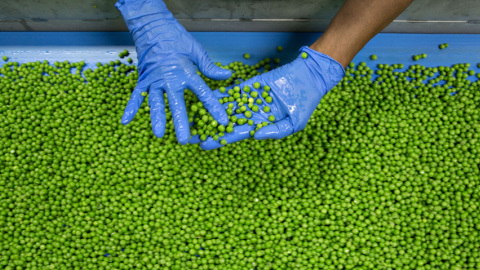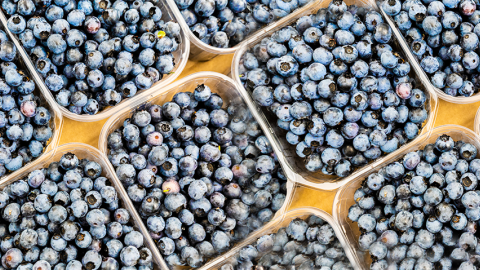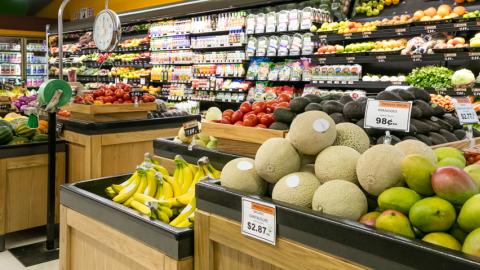This page provides information on:
- Periodic and scheduled ERS publications and data on Fruit and Tree Nuts
- Recent ERS publications related to Fruit and Tree Nuts
The U.S. fruit and tree nuts industry generates about $28 billion in farm cash receipts per year. Produced on less than 2 percent of U.S. agricultural cropland, farm cash receipts from this sector account for approximately 6 percent of the total receipts for all agricultural commodities and around 11 percent for all crops.
USDA’s Economic Research Service (ERS) produces a range of data products and reports that describe changes in domestic supply, demand, trade, prices, and other variables of interest to policy makers, regulators, agricultural producers, and consumers.
The Fruit and Tree Nuts reports and data products present data on fruits and tree nuts in an easy-to-use format that inform decision-making, guide research, and provide insights about commodity markets. While other data products may describe aggregate trends in the fruit and tree nuts sector, the ERS Fruit and Tree Nuts data products provide a time series of commodity-specific information on trade, prices, production, and stocks.
Periodic, Scheduled Outputs
- Outlook reports are published three times per year. These reports describe current market conditions and forecast short-term changes in U.S. fruit and tree nuts markets. Highlights of the most recent Fruit and Tree Nuts Outlook report are available on the Market Outlook page.
- Fruit and Tree Nut Data provide detailed U.S. export and import data, producer and retail price indexes, and a few retail prices.
- Fruit and Tree Nuts Yearbook Tables are updated annually. These reports contain over one hundred data tables describing changes in U.S. bearing acreage, production, prices, trade, per capita use, and more.
- Fruit and Vegetable Prices is a data set that reports average prices of fruit and vegetables (in edible cup equivalents). This data product can help consumers, policymakers, and nutritionists estimate how the cost of eating a balanced diet of fruits and vegetables has changed over time.
Recent ERS Reports Relating to Fruit and Tree Nuts
In addition to the periodic Outlook reports and data products, ERS produces reports covering issues important to fruit and tree nuts markets in the United States and around the world.
Recent ERS reports relating to fruit and tree nuts markets include:
- Federal Programs for Agricultural Risk Management This report provides a broad overview of the Federal programs that are designed to help agricultural producers manage risks to income or profitability caused by natural and economic forces. This report refers to these programs as “risk management programs.” Focus is given to risk management programs that are available under the Agriculture Improvement Act of 2018 (i.e., 2018 Farm Bill) with an emphasis on programs for crop and livestock producers that are available under Title I: Commodity Programs or Title XI: Crop Insurance. Available policies for managing production and price risk are discussed with recent trends in program enrollment and outlays provided.
- How Mexico’s Horticultural Export Sector Responded to the Food Safety Modernization Act ERS researchers conducted interviews with Mexican horticultural growers focused on the export market to explore how their industry responded to the new requirements of the Food Safety Modernization Act (FSMA). Half of the 26 companies interviewed identified training the head of the firm’s food safety program as the main challenge in complying with the act. Medium-to-large companies (300–1,000 seasonal workers) were more likely to have modified their food safety activities and to hold 3 or more food safety certifications—facilitating the sector’s growing presence in the U.S. market.
- Specialty Crop Participation in Federal Risk Management Programs This study characterizes recent changes in Federal Crop Insurance Program (FCIP) and Noninsured Crop Disaster Program (NAP) use by specialty crop farmers, compares differences among conventional and organic farms, and investigates the reasons some farmers choose whether to participate in these programs. Specialty crop growers increased the value of their crops insured by FCIP products from about $12 billion in 2011 to about $21 billion in 2020 (not adjusted for inflation). A case study of nine specialty crop growers in New York State explores reasons they choose whether to participate in these Federal programs.
- Examining the Growth in Seasonal Agricultural H-2A Labor This study analyzes how the H-2A Agricultural Guest Worker program allows U.S. agricultural employers to hire foreign workers on a temporary or seasonal basis. This report explores how H-2A usage levels differ by agricultural sector, geography, and by the type of firm requesting workers. Fruit and tree nut producers were among the highest users of H-2A in 2019.
- Developing Automation and Mechanization for Specialty Crops: A Review of U.S. Department of Agriculture Programs At $64.7 billion, specialty crops comprised one-third of U.S. crop receipts in 2017. Relative to other crops, many specialty crops depend more on agricultural labor for production, harvesting, and processing. This study describes six U.S. Department of Agriculture programs that accelerate the development and use of automation or mechanization in the production or processing of specialty crops.
- Economic Drivers of Food Loss at the Farm and Pre-Retail Sectors: A Look at the Produce Supply Chain in the United States This study provides an overview of the drivers of food loss on the farm and other pre-retail sectors, with a focus on economic incentives that underlie the way fresh foods are grown, processed, and marketed in the United States. The study focuses on the produce sector because fruits and vegetables are highly perishable and important to diet quality.
- U.S. Produce Growers' Decisionmaking Under Evolving Food Safety Standards U.S. produce growers face increased demand for implementing more food safety practices, prompted by a series of high-profile foodborne illness outbreaks. A series of case studies with growers of five commodities (apples, cantaloupe, strawberries, onions, and tomatoes) in six regions reveal the industry's long history of voluntarily adopted food safety standards as well as requirements set by commercial buyers and Government agencies.
- Before Implementation of the Food Safety Modernization Act's Produce Rule: A Survey of U.S. Produce Growers The "Produce Rule" (PR), which began its phased implementation in January 2018, is an on-farm Food and Drug Administration regulation that sets specific disease-preventive requirements for produce that is sold and consumed raw in the United States. The report presents results of a 2015 and 2016 survey of produce growers about their microbial food safety practices before the PR’s implementation.
- Estimated Costs for Fruit and Vegetable Producers To Comply With the Food Safety Modernization Act's Produce Rule This study estimates farm-level costs to comply with the Food Safety Modernization Act's Produce Safety Rule by commodity, State, and farm size. Across commodities and States, differences in costs are driven by differences in farm size and range from 0.3 percent of annual produce sales for the largest farms to 6.8 percent for the smallest.
- Estimated Costs for Fruit and Vegetable Producers To Comply With the Food Safety Modernization Act's Produce Rule Using information from firms participating in the voluntary California Leafy Greens Marketing Agreement, this report provides information on the relative costs that U.S. firms could incur under similar provisions of the Produce Rule under the Food Safety Modernization Act.
- Changes to the Noninsured Crop Disaster Assistance Program Under the Agricultural Act of 2014: Their Potential Risk Reduction Impacts ERS examines impacts of the Buy-Up coverage addition to the Noninsured Crop Disaster Assistance Program (NAP) on expected payments, producers' risk reduction, and NAP enrollment by type of producer and crops.
- The Influence of Income and Prices on Global Dietary Patterns by Country, Age, and Gender Worldwide changes in eating habits are contributing to a global rise in obesity and related noncommunicable diseases (diabetes, heart disease, and stroke) across all countries, including low- and middle-income. To address this issue, this report investigates how income and prices influence dietary habits globally.
- Estimating the Effects of Selected Sanitary and Phytosanitary Measures and Technical Barriers to Trade on U.S.-EU Agricultural Trade This study investigates the effects of nontariff measures (NTMs)—specifically, sanitary and phytosanitary measures and technical barriers to trade—on agricultural trade between the United States and the European Union (EU). Along with tariff reduction, the removal of NTMs has emerged as a key focus of negotiations in the U.S.-EU Transatlantic Trade and Investment Partnership.
- Agriculture in the Transatlantic Trade and Investment Partnership: Tariffs, Tariff-Rate Quotas, and Non-Tariff Measures This study assesses the potential effects of the Transatlantic Trade and Investment Partnership between the United States and the European Union on agriculture under three broad scenarios: complete removal of tariffs and tariff-rate quotas; elimination of non-tariff measures along with tariffs and tariff-rate quotas; and a lowering of the willingness of consumers to purchase imported goods previously limited by nontariff measures.



